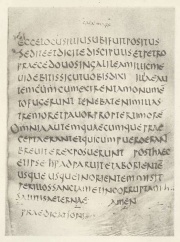Codex Bobiensis
From Textus Receptus
Nick (Talk | contribs)
(New page: Codex Bobbiensis – The last page of the “Gospel of Mark” '''Codex Bobiensis''' ('''k''') is a fragmentary Latin manuscript of the bible. ...)
Next diff →
Revision as of 03:35, 15 January 2011
Codex Bobiensis (k) is a fragmentary Latin manuscript of the bible. Specifically, it is an example of a Vetus Latina bible, which were used from the 2nd century until Jerome's Latin translation, the Vulgate, was written in the 5th century. The text contains parts of the Gospel of Mark (Mk 8:8-end) and Gospel of Matthew (Mt 1:1-15:36). The order of books was probably: John, Luke, Mark, and Matthew.[]
It is from North Africa and is dated to the 4th or 5th century. Later it was brought to the monastery in Bobbio in northern Italy. Traditionally asserted to St. Columban, who died in the monastery he had founded there, in 615.[] Today it is housed in the national library in Turin.
Researchers think, comparing the Codex Bobiensis with quotes from Cyprian’s publications from the 3rd century, that the Codex Bobienses is a page from the Bible Cyprian used while he was a bishop in Carthage.
From a palaeographic study of the scripture, it is a copy of a papyrus script from the 2nd century. Codex Bobiensis is interesting, in that it is the only known scripture which has the addition of Mark 16:9's "short ending", but not the later, "long ending" through Mark 16:20. This is the only known example of the "shorter ending" added directly to Mark 16:8.[]
The Latin text of the codex is a representative of the Western text-type in Afra recension.
Contents |
Textual features
In Matthew 8:12 it has ἐξελεύσονται (will go out) instead of ἐκβληθήσονται (will be thrown). This variant is supported only by two Greek manuscripts Codex Sinaiticus, Codex Climaci Rescriptus, and by syrc, s, p, pal, arm, Diatessaron.[]
In Mark 16:3 it has unusual additional text:
ab osteo? Subito autem ad horam tertiam tenebrae diei factae sunt per totum orbem terrae, et descenderunt de caelis angeli et surgent (-ntes?, nte eo?, surgit?) in claritate vivi Dei (viri duo? + et) simul ascenderunt cum eo, et continuo lux facta est. Tunc illae accesserunt ad monimentum.[]
Codex Bobiensis has led to speculation that the Gospel of Mark was originally written in Latin and not Greek. It is one of the oldest preserved examples of the Gospel of Mark, and because Mark was supposedly traveling in Africa after having written his Gospel, it is thought to be a copy of the Gospel and closer to the original writings than the known Greek versions. Despite these claims, the scholarly consensus still considers the autograph to be in Koine Greek.
See also
References
Further reading
- John Wordsworth, Old Latin Biblical Texts, Oxford 1886

